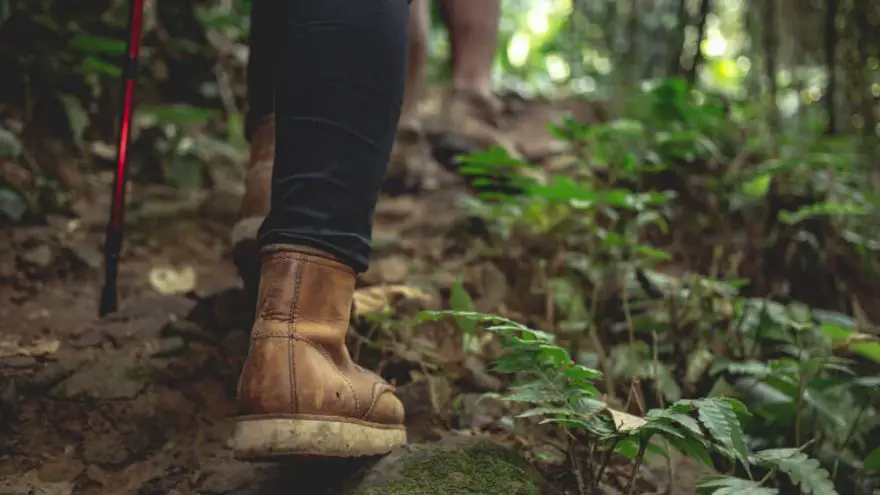The 5 Key Differences Between Mountaineering Boots & Hiking Boots
 The 5 Key Differences Between Mountaineering Boots & Hiking Boots
gearweare.net
The 5 Key Differences Between Mountaineering Boots & Hiking Boots
gearweare.net
Finding the correct gear for your expeditions is crucial. Boots are arguably the most important investment. You need a boot that gives you support, weather resistance has good traction, and is comfortable.
When comparing mountaineering boots vs. hiking boots, you’ll find a few similarities, but do not be tricked; these two boots are made for entirely different outings.
Purchasing the right boot for your backpacking journey will allow you to hike to more exotic locations, function well on multiple terrains, and keep you safe.
Table of Contents
5 Differences Between Mountaineering Boots and Hiking Boots
To the naked eye, mountaineering boots might look like enhanced hiking shoes. In a way, they are.
The main differences you’ll notice with mountaineering boots vs. hikers are:
1. Mountain boots have a higher shaft. You need more ankle support when mountaineering, especially when using crampons.
2. The shank of a mountain boot makes it very stiff. There is little to no flexibility in a mountaineering boot. Boots with a full shank can be used with automatic crampons, while boots with a ¾ shank can only be used with semi-automatic crampons.
Hiking boots have more flexibility, making them more comfortable and easier to climb hills and steps.
3. The outsole and traction of hiking boots are great, but the traction and outsole of mountaineering boots are better. The lugs tend to be deeper, allowing for more grip, especially in snow and ice.
4. Hiking boots are not usually as insulated as mountaineering boots.
5. Mountaineering boots are much more expensive than traditional hiking boots.
Can Mountaineering Boots Be Used for Anything Else?
First, let’s discuss what mountaineering boots should be used for. They are made for mountaineering or alpining, including crevasse traverse, mountain climbing, snow rescue missions, ice climbing, and ice/rock climbing.
Some people try to use mountaineering boots as hiking boots to save money or space. While this is possible for very short hikes or hikes that mostly involve a lot of alpine climbing, it is definitely not ideal for regular day hikes, or short trekking and backpacking trips.
As I mentioned before, mountaineering boots vs. hiking boots have different features that make them less comfortable walking and hiking.
You can use them to approach a ski point, but are usually not compatible with AT bindings, nor are they a good choice even if they are compatible.
What Are the 3 Types of Mountaineering Footwear?
With all shoes, there are multiple styles and options. Mountaineering boots are no different.
There are three main options.
1. Insulated: This pair of boots have a multilayered construction and are usually made from leather or synthetic material. It has good abrasion resistance and is ideal for long, cold approaches in cold weather.
Some insulated boots also include a separate insulated inner boot that you can wear comfortably in your tent for warmth through the night.
2. Three-season: A three-season mountaineering boot is the lightest option. It has little to no insulation and is usually quite comfortable after a proper break-in. Because it has fewer materials, it is usually a less expensive option.
Both insulated and three-season boots are typically finished with a DWR treatment to keep your feet dry.
3. Plastic: This is the type of boot that is most popular when renting mountaineering boots. It has a hard plastic shell with a soft inside. It offers a less customized fit and is quite heavy.
What Should I Look For in a Mountaineering Boot?
Before investing in a boot, you should consider the weather you’ll be climbing in. How much insulation do you need?
You should also know the route you’ll be taking to know if it can be done solely in a mountaineering boot. If there is a lot of loose rock or unstable surfaces and ascents, you’ll also need to invest in a pair of approach shoes.
While it’s difficult to tell at first, you also want to make sure the boot is comfortable. There is quite a break-in period for these shoes, but you shouldn’t have an issue if you get the correct size.
Equally as important as comfort, you also need to research the materials, cushioning and durability of the boot. Investing in a pair that will break within a year is a waste of money.
Also, investigate the weather resistance. Most boots come with a Gore-Tex (GTX) and DWR treatment that needs to be reapplied every so often.
How Should Mountain Boots Fit?
In general, you should buy a mountaineering boot that is a half or full size larger than your everyday shoe. Your toes should wiggle easily, and your heel should slightly lift when walking without painfully rubbing the boot’s heel.
There should be ample room for a thick, insulating sock. Also, keep in mind that your feet might swell during a trek, especially at such high altitudes. Having some wiggle room in the toes will help you avoid bruised toenails and blisters during a descent.
How to Break-in Mountaineering Boots?
Immediately wearing these boots on a week-long excursion would be a terrible idea. Because mountaineering trips are never short, you need to make sure they are broken in and comfortable before you begin your adventure.
To break in mountaineering boots, you should wear them on flat ground for short periods of time. Once they feel comfortable, you are ready to hit the trails. As always, it’s a good idea to carry some band-aids or moleskin with you.
Conclusion
If your excursion has a short, flat hike before reaching the icy, snowy section, you can use your mountaineering boots. However, wearing them for a longer period of time would not be comfortable. Mountaineering boots vs. hiking boots have different flexibility, traction, and stability.
Even if it makes your load a bit heavier, using each boot for its own specific purpose is the best way to explore our beautiful surroundings.











